I highly recommend sponge filters for your aquarium.
Doesn’t matter if you have them on their own or to boost your current filteration. They add so much surface area for beneficial bacteria, they’re easy to set up and operate, and they’re cheap.
In this guide, I’ll show you how to get the best one for you, a way you can create your own high capacity filtration system for under $40, and review the best sponge filters available today.
Overview: Top Picks For Sponge Filters
- Best Sponge Filter For 20-30 gallon (76-113 liters) Tanks: Aquarium Technology Hydro-Sponge III
- Best Sponge Filter For 10-20 gallon (38-76 liters) Tanks: Hygger Double Sponge Filter
- Best Sponge Filter For 5-10 gallon (19-39liters) Tanks: UPETTOOLS Sponge Filter
- Best Sponge Filter For 2.5-5 gallon (9.5-19 liters) Tanks: Aquaneat Round Sponge Filter or Aquaneat Corner Sponge Filter
| Preview | Product | |
|---|---|---|

|
Lustar – Hydro-Sponge III Filter for Aquariums up to 40 Gallons | Buy on Amazon |

|
Hygger Aquarium Double Sponge Filter, Comes with 2 Spare Sponges (S) | Buy on Amazon |

|
UPETTOOLS Aquarium Sponge Filter Ultra Quiet Aquarium Air Pump Bio Sponge Fish Tank Foam Filter... | Buy on Amazon |

|
AQUANEAT Aquarium Bio Sponge Filter Breeding Fry Betta Shrimp Nano Fish Tank (Small up to 10Gal) | Buy on Amazon |

|
AQUANEAT Aquarium Bio Sponge Filter Breeding Beta Shrimp Nano Fish Tank Water Corner Filter 10... | Buy on Amazon |
Last update on 2024-04-19 / Commissions Earned / Images from Amazon Product Advertising API
How I Tested The Sponge Filters
We bought five different sponge filters so that we could use them and compare their features to decide what kind of tank each would be best for.
We unboxed each filter and set them up in one of our 10 gallon (39 liter) tanks. We connected each one to air and let it run for a few days so we could test how loud it was and get an overall feel for what it’s like to use it day in/day out.
We measured the noise level from each filter with a decibel meter to get an idea how loud they really were once they were installed and if there was any kind of workaround to make them quieter.
We took lots of notes and pictures along the way to document all our findings.
Pro Tip: All of the filters were connected to an Aqueon QuietFlow 10 filter for testing. Different air pumps may cause different decibel readings.
My Reviews for the Best Sponge Filters
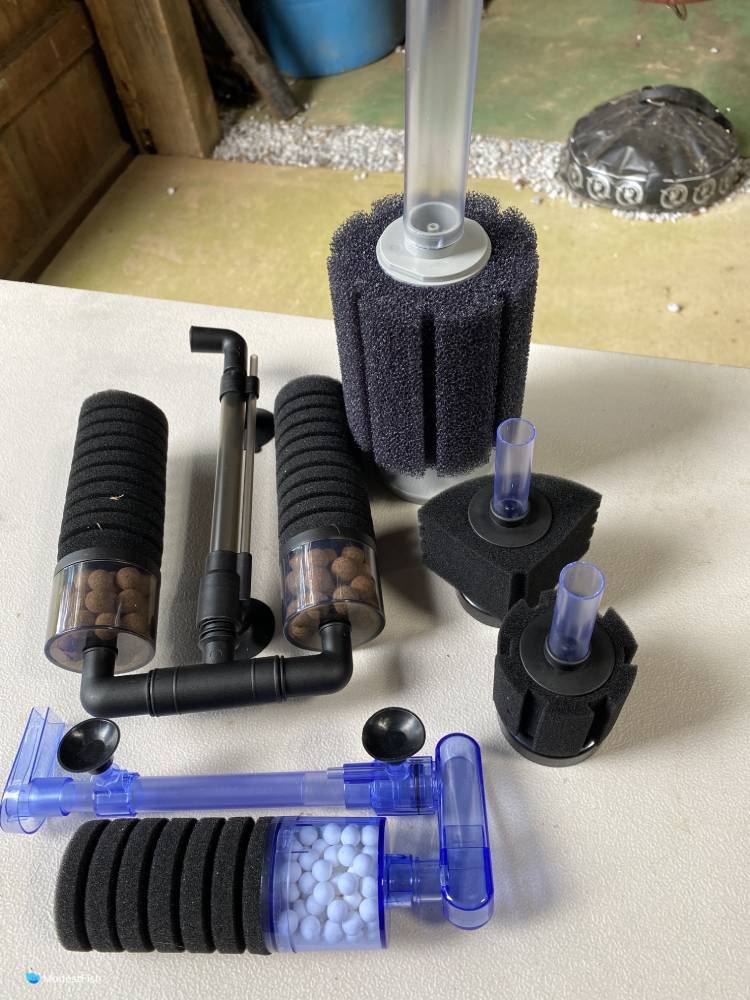
Now you know more about what sponge filters offer, you can use my reviews to make an informed decision on which one is best for you.
1. Aquarium Technology Hydro-Sponge III: Best for 20-30 Gallons (76-113 liters)
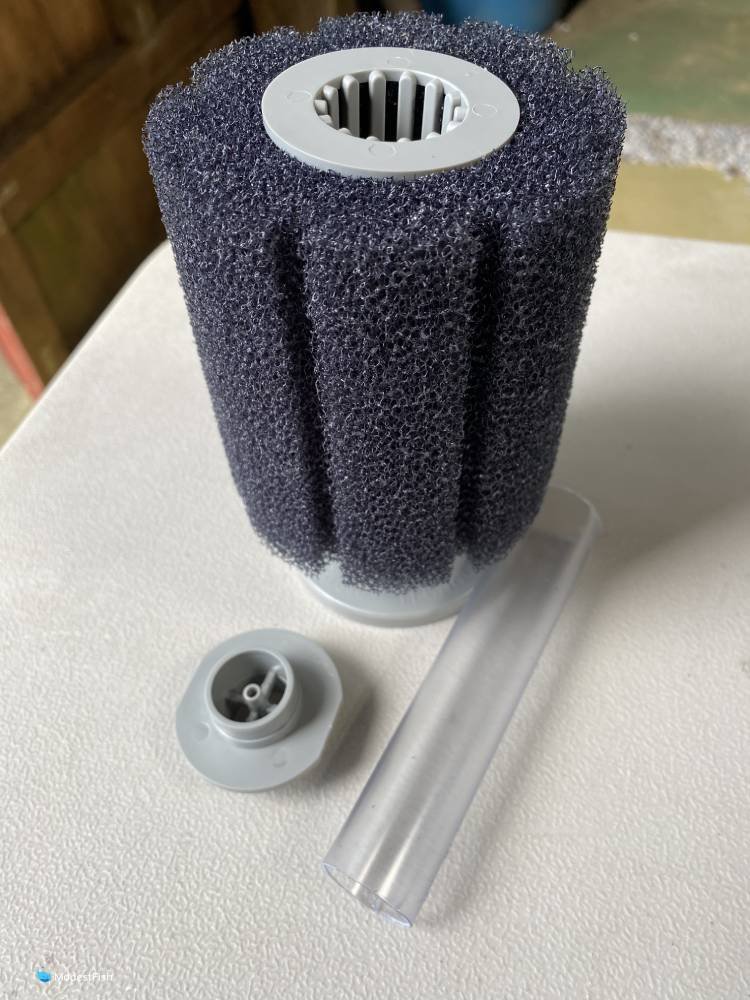
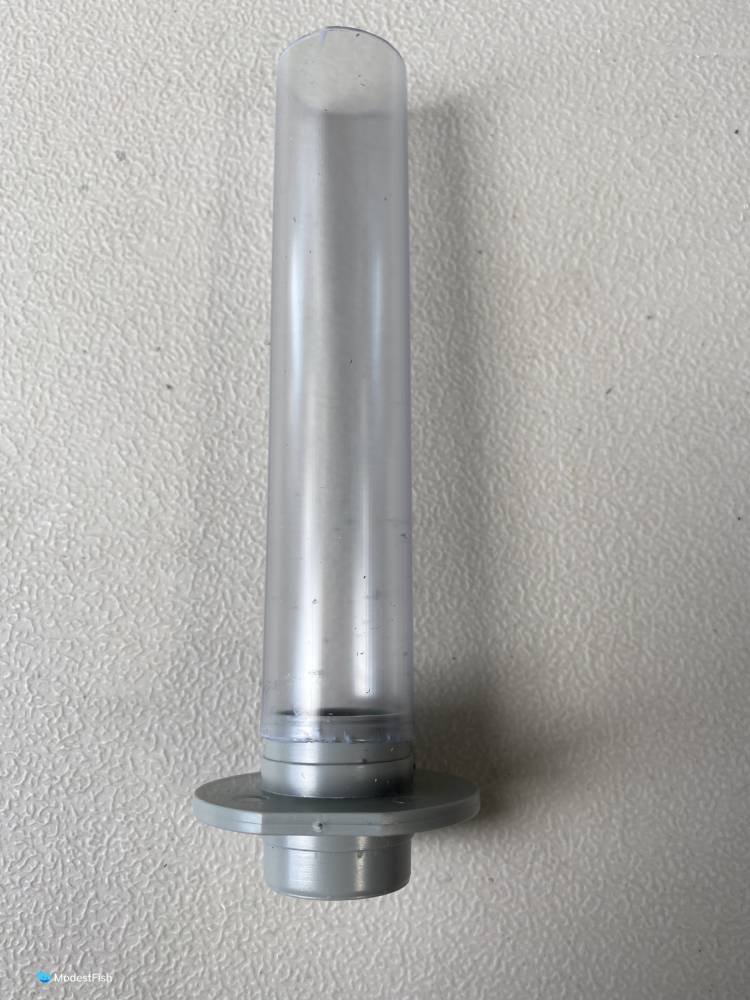
I’ve used Hydro-Sponges for years. There are several different sizes, for teeny tiny nano tanks all the way up to 100 gallon tanks.
The Hydro-Sponge III is the biggest of the five filters we looked at for this article. It’s a great size for 20-30 gallon tanks.
This filter features a large, cylindrical sponge, a weighted foot that keeps the sponge off the floor of the tank and a clear lift tube.
I love the weighted foot on this filter. It keeps the sponge from moving around once the air is pumped through it.
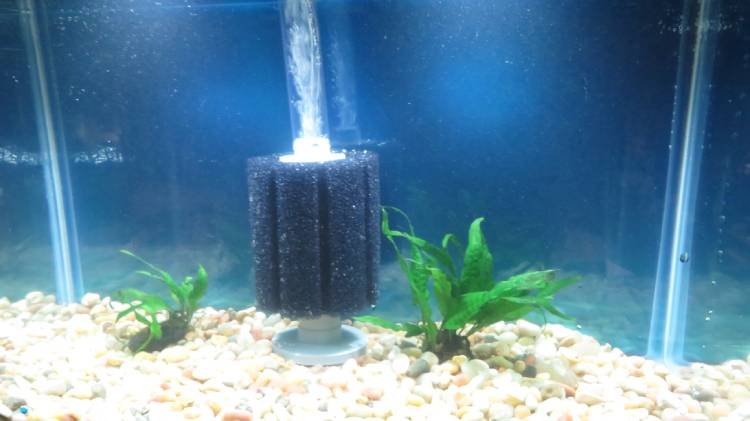
This filter is free standing, so it doesn’t need to be attached to a tank wall. Because of the weighted foot, you can place it anywhere in the tank and it will stay put.
By itself, this sponge filter can be kind of loud. The large bubbles that come out of the lift tube make a “blub, blub” sound as they hit the surface.
But, if you add a Lee’s Discard-a-Stone diffuser, the big bubbles will be broken up into a stream of finer bubbles that are much quieter.
Without a diffuser, this filter put out 65 decibels at the water’s surface. When we added a diffuser, that dropped to 54 decibels. That might not seem like much, but since the decibel scale is logarithmic, that means the filter is 10 times quieter when you add the diffuser. That’s substantial.
Luckily, adding a diffuser takes less than 2 minutes.
You can run this filter either with an air pump or with a powerhead. In my opinion, using an air pump is less hassle, but using a powerhead makes the sponge filter silent.
When the sponge wears out (don’t worry, that could take years) you can buy just replacement sponges, you don’t have to buy a whole new frame and weighted foot.
As much as I like this filter in practical terms, it’s not the best looking device on the market. But, the dark color helps it blend into the background. I usually put rocks of decor in front to mask it a bit. Then you just notice the column of bubbles, not the sponge itself.
Pros:
- Lots of surface area for beneficial bacteria
- Easy to add a diffuser
- Weighted foot keeps it in place
Cons:
- Not attractive to look at
- Noisy unless you add a diffuser

Last update on 2024-04-20 / Commissions Earned / Images from Amazon Product Advertising API
2. Hygger Double Sponge Filter: Best for 10-20 Gallons (38-76 liters)
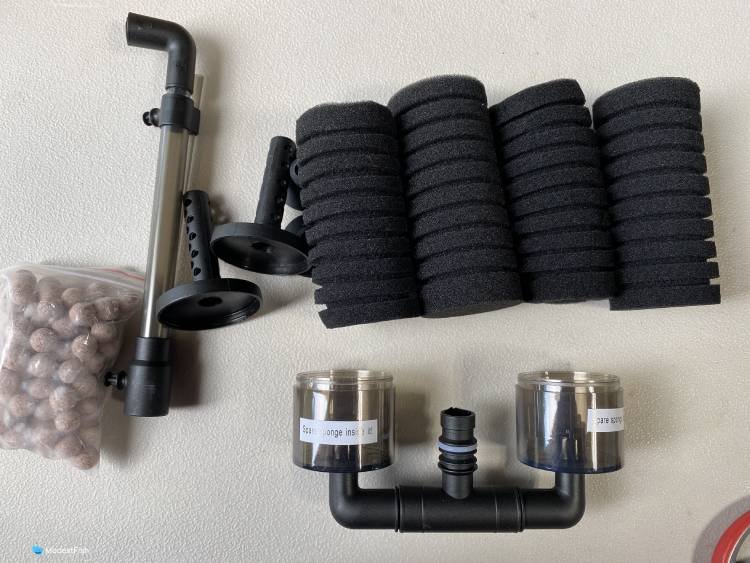
I really like this style of sponge filter. This filter has two sponges, and at the base of each sponge is a chamber that holds ceramic filter media.
I think the ceramic media chambers are a great addition.
I recently started a new 10 gallon (39 liter) tank and decided to use this as the filter. I added some pieces of seasoned ceramic media from the filter running on one of my established tanks.
Adding this seasoned filter media gives the beneficial bacteria population in the new tank a jumpstart, greatly decreasing cycling time and hassle.
I also thought it was awesome that you get the two replacement sponges.
You can only hook this filter up to an air pump, there’s no option for hooking it to a powerhead.
Also, you can’t add a diffuser to this filter. The bubbles coming out of the spout are a little loud. But, if you adjust the spout so that the bubbles come out above the water’s surface, the noise is greatly reduced.
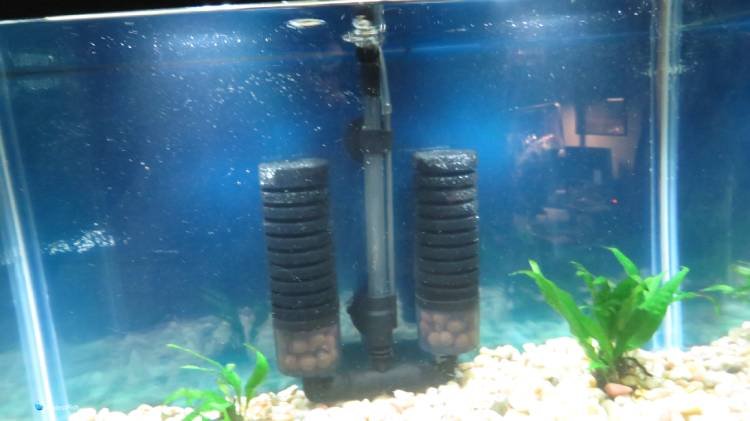
With the spout below the water, the noise was at about 67 decibels. But once we moved the spout above the water, the sound went down to 54 decibels.
This filter attaches to the back of the tank wall with two suction cups, so placement options are limited. If the filter isn’t attached to the glass, it will try to float a bit once the air is turned on.
I really like the look of this style of sponge filter. I’m not quite sure why. It just looks like some gadget you’d see in a lab, I guess. I’m sure some would disagree, but I just think it looks pretty cool and I don’t have plans to try to cover it up in the new tank.
Pros:
- Ceramic media in addition to sponge
- Comes with 2 extra sponges
- Adjustable height spout
- Looks nice
Cons:
- Kind of loud if spout is below the water

Last update on 2024-04-19 / Commissions Earned / Images from Amazon Product Advertising API
3. UPETTOOLS Sponge Filter: Best for 5-10 gallons (19-39 liters)
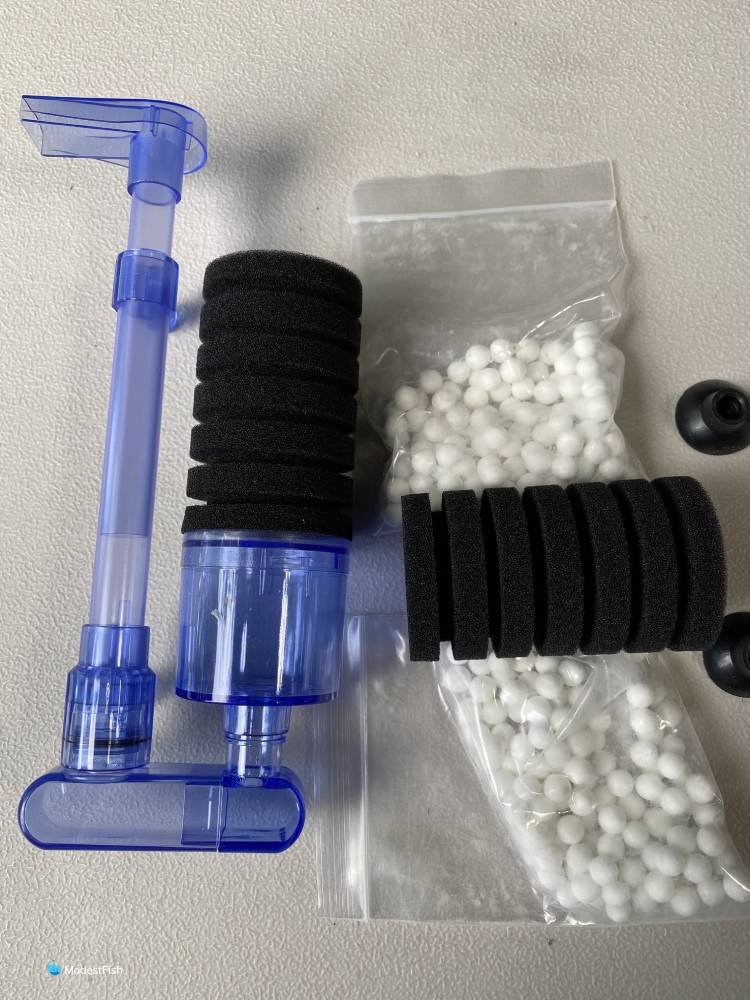
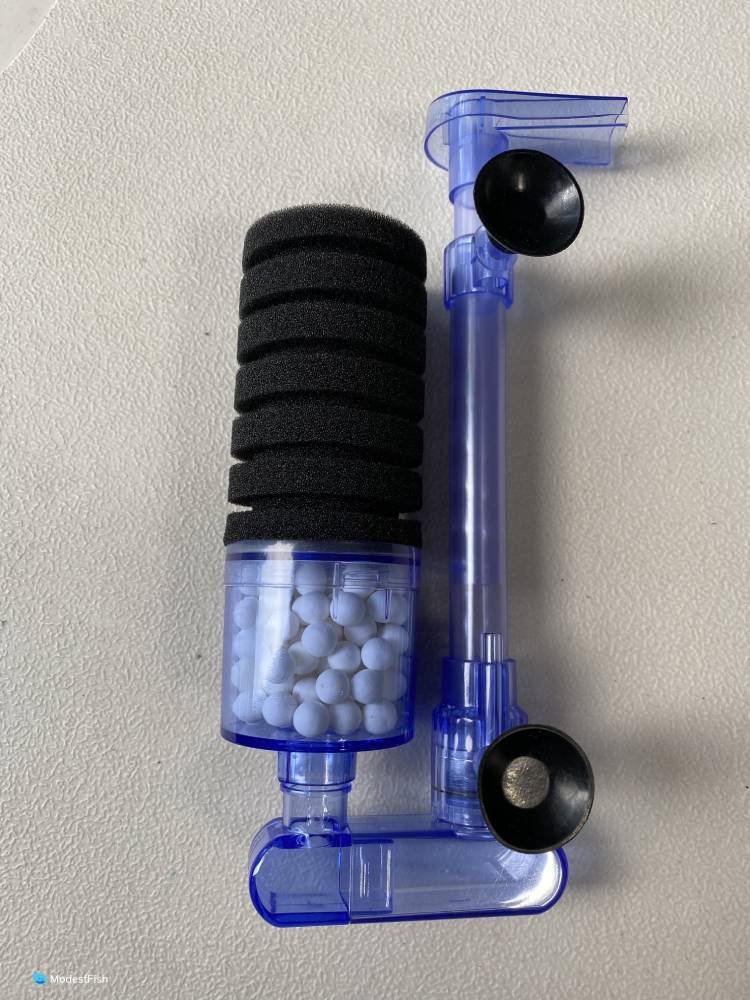
This sponge filter from UPETTOOLS is similar to the Hygger filter, but it only has one sponge instead of two.
It also has a chamber at the base of the sponge that contains ceramic biomedia.
I think this filter is my favorite of the bunch in terms of appearance. The body of the filter is made of a clear plastic with a bluish tinge to it that I like. The shape is also very appealing.
I also really like that the spout that bubbles escape from extends up higher than the one on the Hygger filter. This makes this filter a better choice for taller tanks.
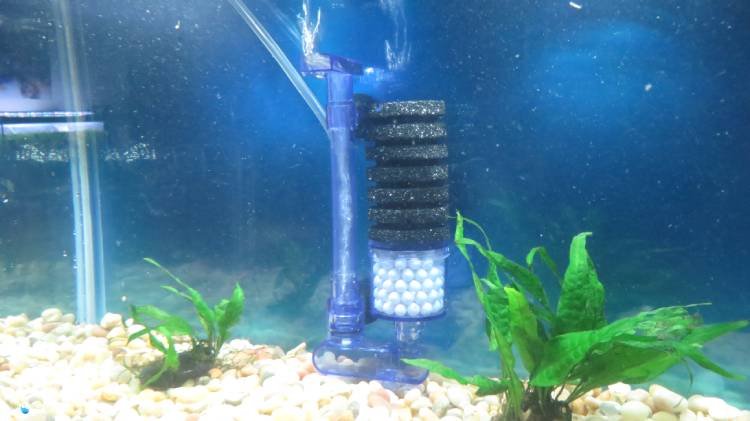
If you keep the spout below the surface of the water, it can be kinda loud. We measured a noise level of 67 decibels. When we moved the spout above the water we got a reading of 54 decibels.
Pros:
- Extra chamber for ceramic media
- Cool looking design
- Spout has a long extension tube
- Includes extra sponge
Cons:
- Can be loud if the spout is below waterline

Last update on 2024-04-19 / Commissions Earned / Images from Amazon Product Advertising API
4. Aquaneat Round Sponge Filter: Best for 2.5-5 gallons (9.5-19 liters)
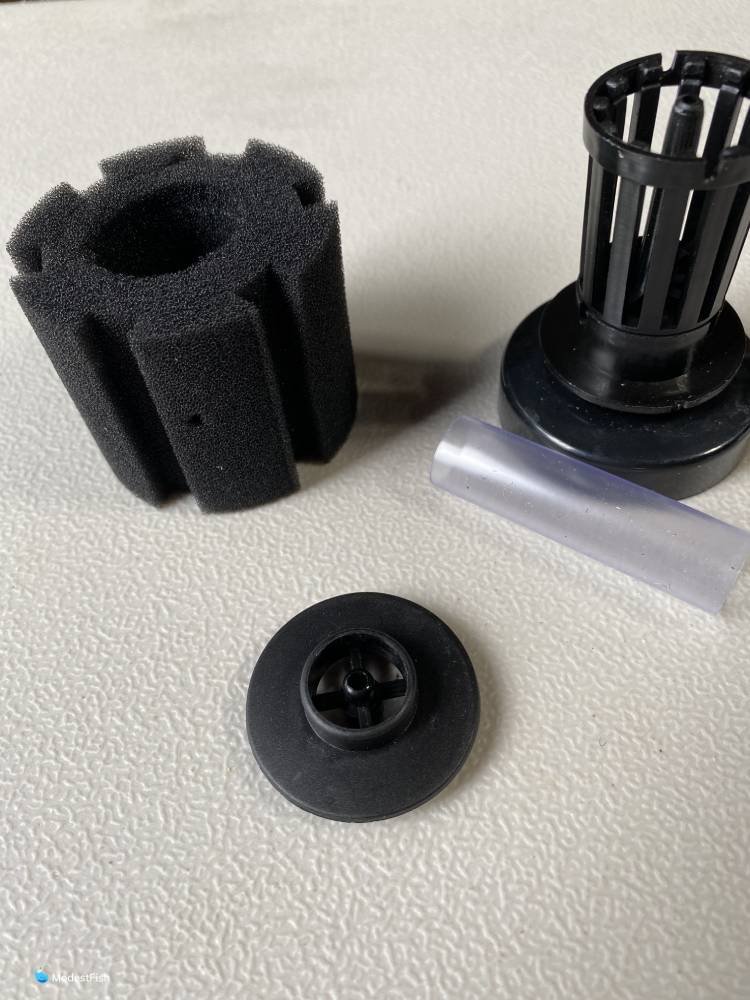
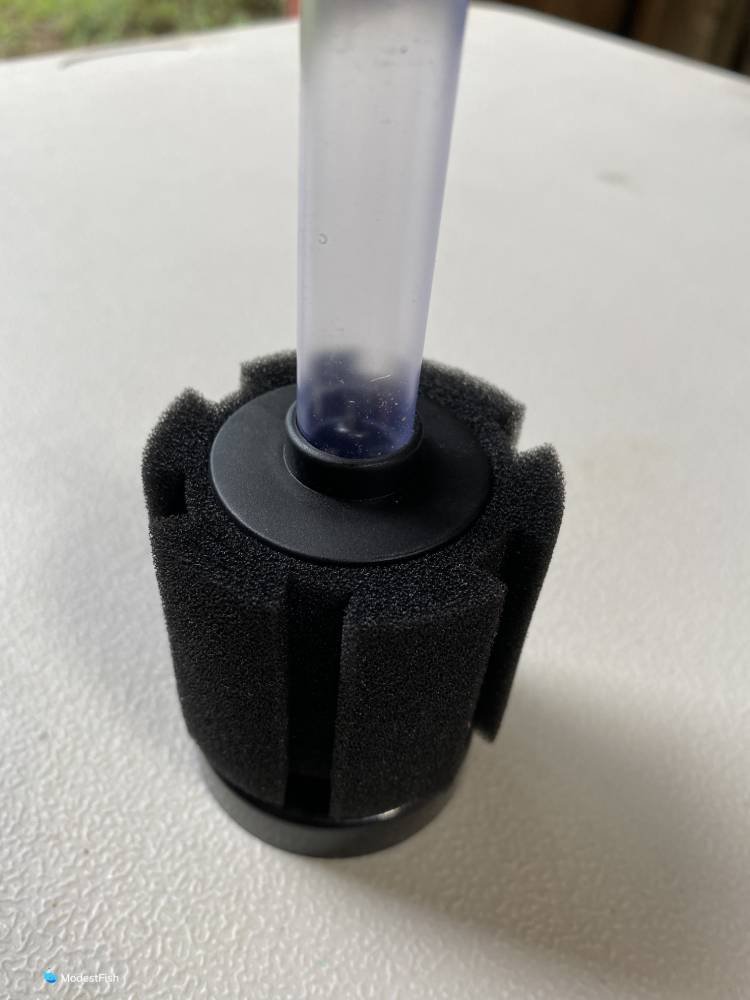
I couldn’t believe how little and cute this filter was when I unboxed it! It looks like the Hydro-Sponge had a tiny baby.
This would be a great filter for a small tank. It wouldn’t take up much room but would still provide a lot of surface area for beneficial bacteria.
Unlike the bigger Hydro-Sponge, you can’t add a diffuser to this filter. So, despite its tiny size, this filter is louder than the bigger ones on this list. We got a reading of 62 decibels and couldn’t find a workaround to make it quieter.
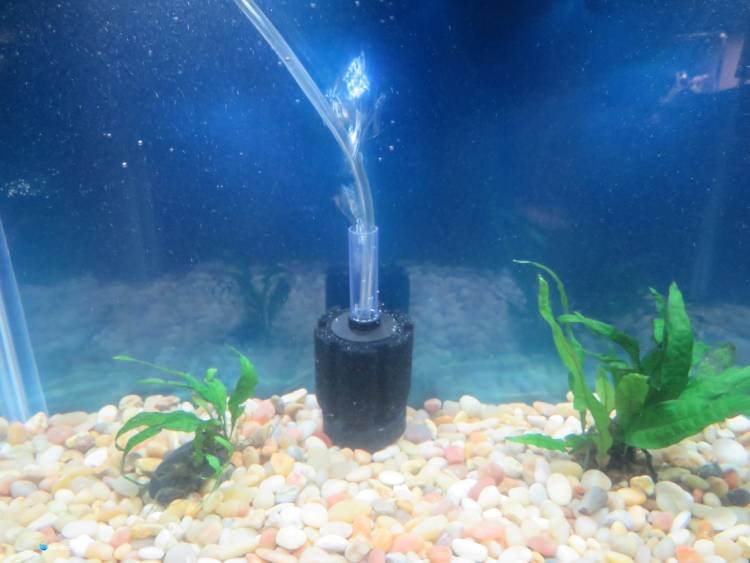
This filter has a weighted base to keep it in place. But, it’s so light that it is still easy to accidentally move it when the air is on.
Since this filter is so tiny, it’s really easy to disguise it with plants or decor.
Technically, you could connect this sponge filter to a powerhead, but it’s so small, I think that would be more trouble than it was worth. I’d recommend using an air pump for this one.
Pros:
- Tiny size makes it easy to hide
- Great fit for smaller tanks
Cons:
- So light that it’s easy to accidentally move it
- Can’t add a diffuser

Last update on 2024-04-20 / Commissions Earned / Images from Amazon Product Advertising API
5. Aquaneat Corner Sponge Filter: Best for 2.5-5 gallons (9.5-19 liters)
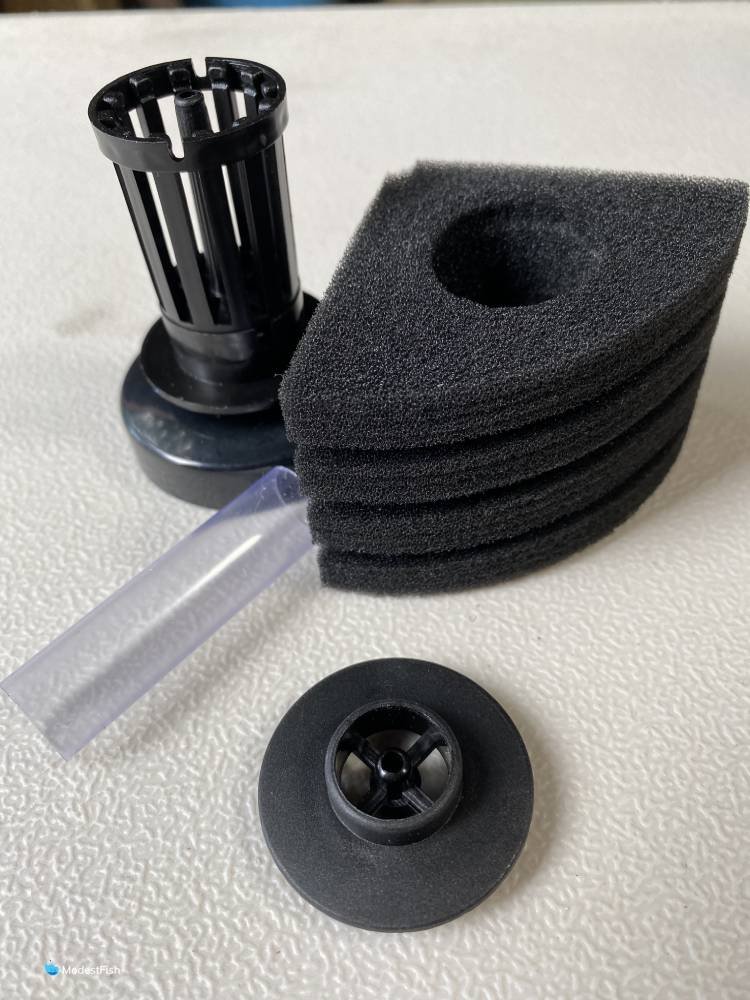
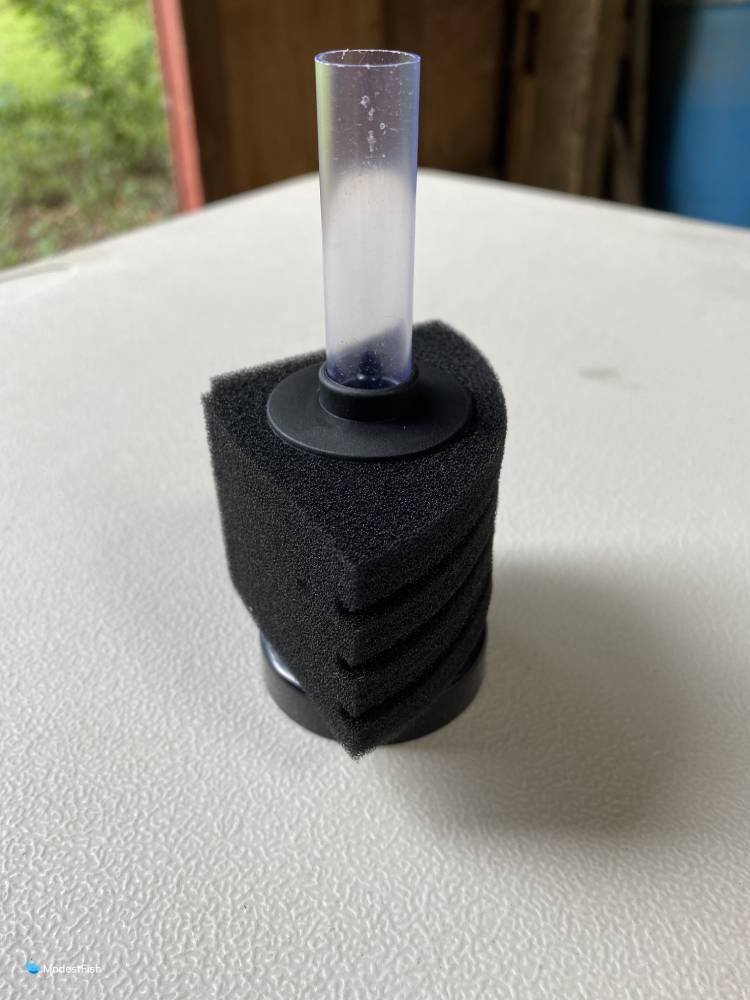
This Aquaneat sponge filter is super cool because it’s shaped like a piece of pie so that it fits right up against a corner in the tank.
I really like this shape, you can more easily tuck it up into a back corner and disguise it with some plants.
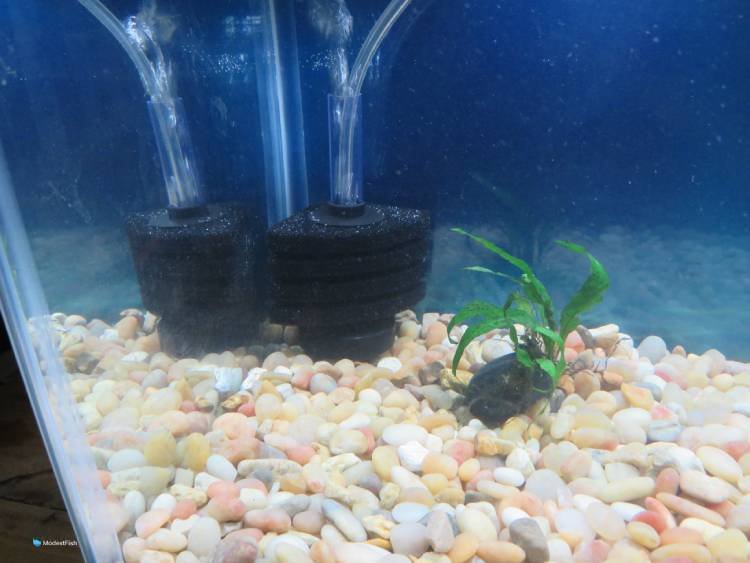
Just like the round Aquaneat filter, you can’t add a diffuser to this filter. It is slightly quieter than the other Aquaneat filter, we measured 61 decibels when we tested it out.
Despite a bit of extra noise, this is a great little filter, I’d especially recommend it for Betta tanks.
Pros:
- Shape makes it fit tightly into the corner
- Super easy to hide with decor
Cons:
- Can’t add a diffuser
- Easy to knock out of place

Last update on 2024-04-19 / Commissions Earned / Images from Amazon Product Advertising API
Choosing The Best Sponge Filter For You
Sponge filters are an awesome way to add more filtration to your aquarium, especially for smaller tanks.
They’re great for delicate or tiny aquarium inhabitants, like fry or shrimp. And the low flow they put out is ideal for Bettas.
I think the Hydro-Sponge is your best bet for larger nano tanks; it’s a bit too hulking for smaller aquariums. This sponge should be plenty of filtration for tanks up to 30 gallons (113 liters).
The Hygger filter would be great for a 20 gallon (76 liter). The added ceramic media gives you lots of room for beneficial bacteria.
The UPPETTOOLS filter has a really cute design that would be best for a 10 gallon (39 liter).
And when it comes to the smaller Aquaneat filters, it’s more about your preference about the shape more than anything else. Either one would work well for tanks up to 5 gallons (19 liters). I love the little corner-shaped one.
I enjoyed testing out all these sponge filters. So much of my efforts have gone into big tanks for so long that it was neat to mess around with some for tiny tanks for once.
I hope you find this article helpful.
I wish you and your fish the very best!
| Preview | Product | |
|---|---|---|

|
Lustar – Hydro-Sponge III Filter for Aquariums up to 40 Gallons | Buy on Amazon |

|
Hygger Aquarium Double Sponge Filter, Comes with 2 Spare Sponges (S) | Buy on Amazon |

|
UPETTOOLS Aquarium Sponge Filter Ultra Quiet Aquarium Air Pump Bio Sponge Fish Tank Foam Filter... | Buy on Amazon |

|
AQUANEAT Aquarium Bio Sponge Filter Breeding Fry Betta Shrimp Nano Fish Tank (Small up to 10Gal) | Buy on Amazon |

|
AQUANEAT Aquarium Bio Sponge Filter Breeding Beta Shrimp Nano Fish Tank Water Corner Filter 10... | Buy on Amazon |
Last update on 2024-04-19 / Commissions Earned / Images from Amazon Product Advertising API
FAQ: How to Clean a Sponge Filter
Cleaning a sponge filter is super easy.
- Siphon some water out of your tank into a large bucket.
- Remove the sponge filter and take it off the strainer.
- Then just squeeze the sponge in the old tank water several times to get out the gunk. You’ll be amazed how much yucky stuff will come out of a sponge, even a small one.
- Discard the water and put your sponge filter back together.
- Voila, you’re done!
Pro Tip: Always use dechlorinated water. The chlorine in tap water can kill the beneficial bacteria living in your sponge.
Benefits Of A Sponge Filter
Biological Filtration
It’s actually impossible to run a successful aquarium without biological filtration.
It’s just a matter of fact, fish pee and poop in the water that surrounds them. It’s gross, but true.
As fish waste breaks down in the tank, it puts off ammonia (NH3).
This really bad because ammonia is highly toxic.
It’s possible for the ammonia to just keep building and building, until the water is pretty much toxic and every fish in the tank will die.
Lucky for us, we have some helpers that make our tanks livable.
What is Biological Filtration?
Biological filtration is just a fancy way of saying that the byproducts of fish waste in the tank are converted from toxic substances to non-toxic ones.
It’s actually colonies of beneficial bacteria growing in our filters that detoxify waste.
These helpful microorganisms turn ammonia into nitrite (NO2 -1) and then nitrate (NO3-).
Nitrate is much less toxic, so it can be allowed to build up in the tank in between weekly water changes.
Pro Tip: The beneficial bacteria you need for your tank don’t just appear as soon as you set up the aquarium. It takes time and patience to get the nitrogen cycle going in your tank so that it can support fish.
Take a look at this article for steps on how to get your tank cycled and ready for fish and invertebrates.
These super helpful beneficial bacteria need a place to live, though.
They actually produce a natural kind of glue and attach to themselves to porous surfaces where’s there’s a lot of water flow.
Beneficial bacteria love sponge filters. All the tiny pores in the sponge provide a lot of surface area that the bacteria can attach to.
Beneficial bacteria are aerobic, meaning they need oxygen to live. So they need a constant supply of oxygen from water flowing over them.
Sponger filters are awesome for this because water flows through them so easily, providing the bacteria with the oxygen they need.
Basically, a sponge filter is like a luxury condo on the beach as far as beneficial bacteria are concerned.
2-in-1 Filter
Sponge filters aren’t just biofilters, they’re also effective mechanical filters. They’re great for grabbing any little particles and detritus in the water column.
They also trap a good amount of fish poop.
The first time you clean one of these out, you’ll be shocked by the amount of gunk that even a small sponge can hold.
Aeration
Sponge filters also help aerate your tank, especially ones that use an airstone.
I’ve run 10 gallon tanks using only a sponge filter for aeration and it worked great.
In a bigger tank, it’s great to put a sponge filter on the end opposite your hang-on-the-back filter. This is especially great for long tanks.
Having flow on both ends of the tank helps eliminate dead spots and gets all the water in the tank moving.
Fry and Shrimp Safe
Using a sponge filter is a great idea for fry and/or shrimp tanks.
Tiny fry and shrimp can easily get sucked up by the intake of a hang-on-the-back or canister filter.
This can’t happen with a sponge filter since there’s nothing for them to get sucked into.
In fact, both shrimp and fry will often feed off the surface of a sponge filter, eating algae, trapped food, bacteria and other lovely gunk they find tasty.
Cycled Back Up Filter
Running sponge filters in your tank can really save your bacon in an emergency.
Hang-on-the-back and canister filters can suddenly conk out on you. It can be really bad if you don’t realize it right away.
It’s possible to not notice for a day or two, especially if you use a canister filter. The lack of waterflow can kill all the beneficial bacteria in the filter.
That can leave you in a really bad spot and facing going through a “fish in” cycle in your tank, putting your livestock at risk.
But, if you’re running a sponge filter, in addition to your hang-on-the-back or canister filter, you’ve always got a backup that is already full of beneficial bacteria.
They’re also easy to move from one tank to another if you need to.
Pro Tip: Just be aware, whenever you transfer anything from one tank to another, even between two of your own tanks, there is a risk of cross contamination. That means, if there is some sort of disease or parasite in one tank, it can hitch a ride into the new tank.
I’ve also used cycled sponges to kickstart the nitrogen cycle in a new tank.
That way, you can immediately have a filter that has a colony of beneficial bacteria, instead of going through a fishless cycle for several weeks.
Low Flow Tanks
Some species of fish, like Bettas, don’t really like a fast moving current in their tanks. This makes an air driven sponge filter the perfect choice.
It gives you aeration plus mechanical and biological filtration, without creating so much flow that the poor Betta gets blasted all over the tank.
Budget Friendly
Compared to a quality hang-on-the-back or canister filter, sponger filters are cheap, especially air driven ones.
Let’s say you’ve got a 20 gallon (75 liter) tank. You can buy the components to set up a sponge filter for less money than a quality hang-on-the-back.
- Sponge filter
- Air pump
- 6 pack of air diffusers (which will last you forever by the way)
- Airline tubing
- Airline check valve
This can often come out to less than $30-40.
That gives you a filter, with a lot more biofilter capacity than a hang-on-the-back for less than most setups. Plus, it’s simple to set up and maintain, and it would be more reliable than a power filter.
| Preview | Product | |
|---|---|---|

|
AQUANEAT Sponge Filter, Corner Fish Tank Filter, for Breeding Shrimp Nano Fish Tank (Up to 15Gal) | Buy on Amazon |

|
Tetra Whisper Aquarium Air Pump for Fish Tanks 20 to 40 Gallons, Quiet Powerful Airflow,Black | Buy on Amazon |

|
Lee's Pet Products ALE12520 6-Pack Discard a Stone Disposable Air Diffuser for Aquarium Pump, Coarse | Buy on Amazon |

|
Lee's Airline Tubing, 25-Foot, Standard,White | Buy on Amazon |
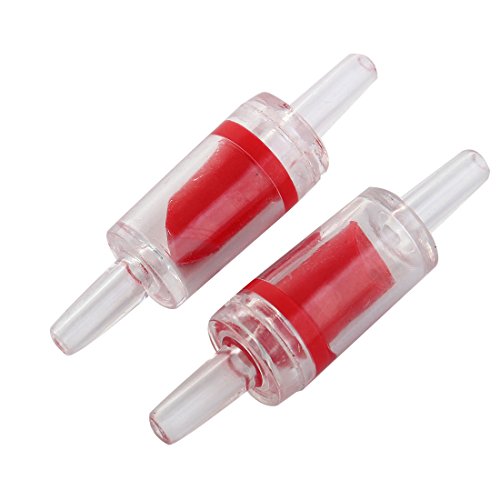
|
Water & Wood Non-Return Plastic Air Pump 2-Piece Check Valves for Aquarium, Red/Clear | Buy on Amazon |
Last update on 2024-04-19 / Commissions Earned / Images from Amazon Product Advertising API
Disadvantages of a Sponge Filter
As much as I love sponge filters, they do have some downsides.
No Chemical Filtration
There’s really no way to add chemical filtration to most sponge filters.
While I’m a big believer that you don’t need to run chemical filtration all the time, there are instances when it comes in really handy, like running carbon to remove medications.
Not the Best Looking
Yep, sponge filters are not going to win any beauty awards. They are kind of a big ugly thing inside the aquarium.
But, in my opinion, you can hide them pretty well with plants and decor.
GPH Rating
When you shop for sponger filters, you’ll see that they’re rated for different tank sizes. So one might be rated for “up to 10 gallons” and another is “up to 60 gallons.”
But what does this really mean?
It partly comes down to how much water can pass through the sponge in an hour. Gallons per hour (GPH) is important because water needs to flow through the sponge so that the beneficial bacteria living inside it can grab waste out of the water column and process it.
The other part of the equation is the size of the sponge. It’s not just how many gallons move through it, it also needs a big enough surface area to sustain the numbers of bacteria you need.
Pro Tip: The ratings on filters don’t take bioload into account, just the volume of water. The heavier the bioload, the more filtration you need.
More is Often Better
For larger tanks, it may be a good idea to run several smaller sized sponge filters rather than relying on one big one. By running smaller sponges in multiple locations around the tank, you increase water flow and cut down on dead spots.
Also, several medium sized sponges can easily have a much greater surface area than just a single large sponge.
You can often run several sponges off of one air pump by using T-valves to split the airflow across multiple airlines.
